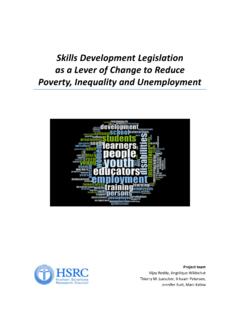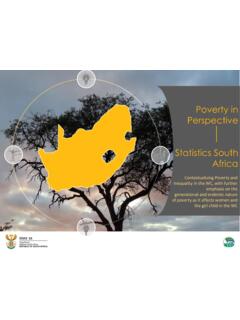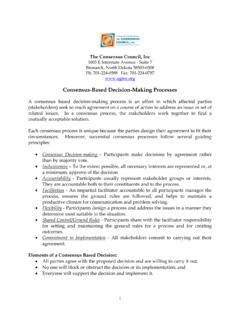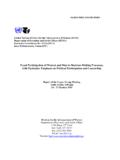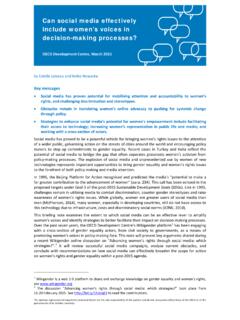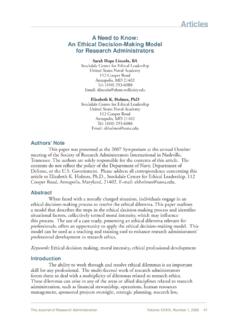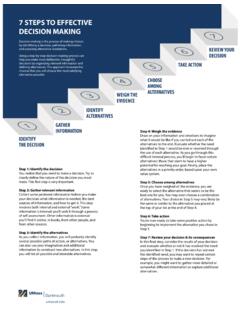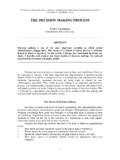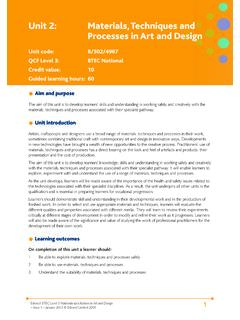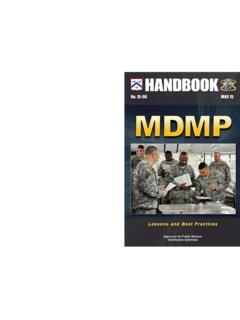Transcription of CHAPTER FIVE PUBLIC PARTICIPATION MODEL
1 CHAPTER FIVE. PUBLIC PARTICIPATION MODEL . A People's Parliament' requires an institution that prioritises and seeks active engagement with the PUBLIC , and that is receptive and responsive to the needs of the people1. The vision of Parliament, since the first democratic Parliament of the Republic of South Africa, was and remains to build a truly representative people's Parliament. Parliament's role and outcomes are to represent the people and ensure government by the people under the Constitution, as well as to represent the provinces and local government in the national sphere of government. In addition, the facilitation of PUBLIC PARTICIPATION and involvement in its processes therefore remains central to the mandate of Parliament. PUBLIC PARTICIPATION has evolved since the first democratic elections.
2 The nature of PUBLIC PARTICIPATION radically changed with the drafting of the new South African Constitution in 1996. The new Constitution asserts that South Africa is a Constitutional democracy country that upholds representative and participatory democracy. In a representative context, the Members of Parliament (MPs) represent the views of the electorate whilst in a participatory democracy the PUBLIC is actively involved in decision- making processes such as law making and oversight. The intention of PUBLIC PARTICIPATION and involvement in democratic processes is primarily to influence decision- making processes that reflects the will of the people'. Subsequently, the South African Legislative Sector recognised the need to operate within a structured framework of PARTICIPATION . The Legislative Sector, consisting of Parliament and all nine provincial Legislatures, thus conceived a Sector PUBLIC PARTICIPATION Framework that provides a documented platform for shared understanding, alignment and minimum requirements and guidelines for PUBLIC PARTICIPATION .
3 The Framework was adopted by the Speakers' Forum and requires 1 Ben-Zeev and Waterhouse (2012). Parliament and provincial Legislatures to fashion their own PUBLIC PARTICIPATION Models. It is on the basis of the Framework that this MODEL was developed. Principles and Values Underpinning PUBLIC PARTICIPATION In terms of Section 12 of the Constitution (RSA, 1996), South Africa is one, sovereign, democratic state founded on the following values: Human dignity, the achievement of equality and the advancement of human rights and freedoms;. Non-racialism and non-sexism;. Supremacy of the constitution and the rule of law; and Universal adult suffrage, a national common voters' roll, regular elections and a multi-party system of democratic government, to ensure accountability, responsiveness and openness. Principles of PUBLIC involvement: Promotes active and representative PARTICIPATION towards enabling all community members to meaningfully influence the decisions that affect their lives.
4 Engages community members in learning and understanding community issues, and the economic, social, environmental, political, psychological, and other associated courses of action;. Incorporates the diverse interests and cultures of the community in the development process, and disengages from support of any effort that is likely to adversely affect the disadvantaged members of a community;. Actively enhances the leadership capacity of community members, leaders and groups within the community; and Utilises a community's diversity to deepen shared understanding and produce outcomes of long-term benefit to the whole community or society. 2 Founding provisions in the Constitution of the Republic of South Africa (1996). The International Association for PUBLIC PARTICIPATION has developed what it considers generally accepted core values and principles for the practice of PUBLIC PARTICIPATION , the purpose of which is to help make better decisions that reflect the interests and concerns of potentially affected people3.
5 According to these values and principles, PUBLIC PARTICIPATION : Is premised on the belief that those who are affected by a decision have a right to be involved in the decision- making process;. Includes the notion that the PUBLIC 's input will be considered;. Promotes sustainable decisions by recognising and communicating the needs and interests of all participants and decision makers;. Seeks to facilitate the involvement of those potentially affected by or interested in a decision;. Seeks input from participants in designing how they participate;. Provides participants with the information they need to participate in a meaningful way; and Communicates to participants how their input fashioned the decision. Goal and Objectives of the PUBLIC PARTICIPATION MODEL Goal The MODEL seeks to outline and mainstream minimum norms and standards for PUBLIC PARTICIPATION processes and procedures to achieve meaningful involvement of the PUBLIC in the legislative and other processes of Parliament.
6 Objectives The MODEL intends to achieve, amongst others, the following objectives: To clearly define PUBLIC PARTICIPATION processes and procedures within the context of Parliament;. To outline the procedure to be followed to obtain the views of the PUBLIC on policy, legislation and other matters before Parliament in order to enrich the decision- making processes and to determine the timelines within which could be achieved;. To provide for ways and means of imparting knowledge and information to communities/ PUBLIC about matters before Parliament so as to enable them to participate in the decision- making processes on matters affecting them;. To provide for ways and means of obtaining information from the PUBLIC about experiences of the people with regard to service delivery and government action in order for the institutions to take the necessary action to bring about change.
7 To detail the required institutional arrangements and clarify the roles &. responsibilities for administration and offices within Parliament responsible for the implementation of the MODEL ;. To implement the High Level Panel recommendations; and To provide monitoring indicators for the implementation of the MODEL . Legal Landscape: PUBLIC PARTICIPATION Since 2006, the right to participate in the legislative processes has been considered by a number of courts. The Constitutional Court in Doctors for Life International v Speaker of the National Assembly placed the right within a rich historic and international context. The Constitutional Court examined the historical development of the idea of allowing the PUBLIC to participate in parliamentary decision- making . From the Middle Ages, the Court found, the Magna Carter guaranteed the right to petition the government.
8 This idea became entrenched in English constitutionalism and the English colonists brought it along to the United States. Today the First Amendment to the Constitution of the United States of America protects the right to petition. The Court also referred to the Basic Law of the Federal Republic of Germany, which similarly protects the right to present written requests to Parliament or other authorities. Recent constitutions promoting PUBLIC PARTICIPATION in legislative functions that the Court looked at included those of Tanzania, Portugal, and Colombia. The Constitutional Court examined a number of international and regional human rights instruments, including the International Covenant on Civil and Political Rights, the African Charter on Human and Peoples' Rights, the American Convention on Human Rights, the Harare Commonwealth Declaration, the Inter-American Democratic Charter and declarations of the Inter-Parliamentary Union.
9 It found that the right consists of at least the right to take part in PUBLIC affairs and the right to vote or be elected. In concluding this part of its judgment, the Constitutional Court held that right to political PARTICIPATION in international law includes, in addition these two elements, the duty to facilitate PUBLIC PARTICIPATION in the conduct of PUBLIC affairs by ensuring that citizens have the necessary information and effective opportunity to exercise the right to political PARTICIPATION . The duty to facilitate PUBLIC involvement in legislative and other processes of legislatures is therefore a manifestation of the right to participate in international law, although a more specific form of political PARTICIPATION . The facilitation by Parliament of the involvement of the PUBLIC in the law making process and the processes of its Committees has been a subject of judicial interpretation by both the Supreme Court of Appeal (SCA) and the Constitutional Court.
10 The SCA had an opportunity to comment on the nature of the obligation of Parliament to facilitate PUBLIC involvement in the law making process in the case of King and Others v Attorneys Fidelity Fund Board of Control and Another. The applicants in the matter complained that in enacting the Attorneys Amendment Bill the National Assembly failed to comply with a Constitutional obligation. According to them, the failure to facilitate PUBLIC involvement in the law making process rendered Attorneys Amendment Act Constitutionally invalid. At paragraph 22, the SCA said the following: PUBLIC involvement is necessarily an inexact concept, with many possible facets, and the duty to facilitate it can be fulfilled not in one, but in many different ways. PUBLIC involvement might include PUBLIC PARTICIPATION through the submission of commentary and representations: but that is neither definitive nor exhaustive of its content.







